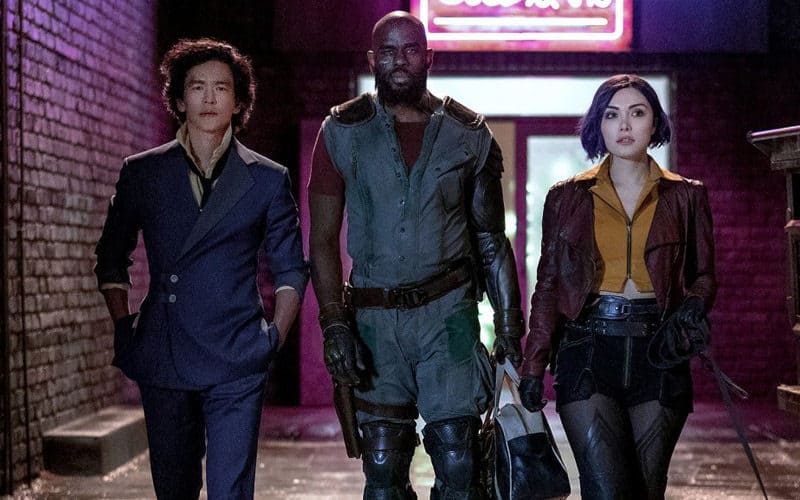‘Cowboy Bebop’ Season 1 Review: Mixed Bag, But A Fun Ride

Cowboy Bebop Season 1, developed by Christopher Yost, creates a neo-noir cyberpunk stylized world. But there are some issues with how the characters are depicted. It’s a fun romp, but there is nothing revolutionary or profound about the first season.
I’m not a fan of the original Cowboy Bebop anime series. All my opinions are based solely on the live-action television show. Julia (Elena Satine) does not fit the mold of the femme fatale character. However, the dialogue, costumes, set pieces, music, and locations do an excellent job of establishing Cowboy Bebop’s vibe.
The series is about two “cowboys,” a.k.a. bounty hunters named Spike Spiegel (John Cho) and Jet Black (Mustafa Shakir), who chase down criminals across the Solar System on the Bebop spaceship.
Spike is trying to outrun his past as a Red Dragon Crime Syndicate gangster named Fearless. Fearless fell out with his former best friend Vicious (Alex Hassell) over femme fatale Julia. Jet wants back into his daughter’s life and mourns the loss of his career as a cop.
The partners meet queer bounty hunter Faye Valentine (Daniella Pineda), who doesn’t remember her past because she suffers from amnesia. She was revied from cryosleep way too late.
Non- Femme Fatale
The character of Julia does not fit the mold of a femme fatale. Along with the fact that the series oversells Julia’s relationship with Spike.
First, femme fatales are usually seen through the eyes of the morally gray male protagonist. He gets tricked into murdering somebody or committing another horrible crime for a beautiful woman who appears to be in trouble.
Julia is a gorgeous woman, and Spike is a morally grey protagonist, but that is where the similarities stop. If the sucker that Julia seduces is supposed to be Spike, then why is she barely in the same room as him?
While dating Vicious, Julia briefly had an affair with Fearless (Spike). Fearless wanted to run away from syndicate life with Julia, but a serious attempt on his life stopped him. So Fearless became Spike to escape Vicious’ tendrils.
Julia did not act like a femme fatale in the background story. The only time Julia appears to be a femme fatale toward Spike is in the “Binary Two-Step.”
Londas, an intelligent A.I., traps Spike into a virtual reality where his tether to life, a.k.a. Julia, tries to convince him to walk away from her. Londas wants to suck out Spike’s life, but it’s not the “real” Julia trying to hurt the cowboy emotionally.
Julia also clearly can’t be the femme fatale toward morally corrupt Vicious. Julia uses her female wiles to keep Vicious in control while she organizes his assassination. But Viscous is an evil, out-of-control man who physically abuses Julia. She shoots Vicious to death, but that’s mainly to protect Spike.
Julia suddenly wants to take over the Red Dragon Crime Syndicate and becomes Spike’s main antagonist. But even then, Julia is not a femme fatale because she openly asks Spike to join her as co-ruler. She doesn’t use mystery, trickery, or beauty to convince him.
Femme fatales are usually mysteries to the main character. They use deception to persuade men to fall to their doom.
Julia shoots Spike out of the building, but it’s no big shock after he refuses to join her.
Neo-Noir & Cyberpunk
Cowboy Bebop is a stylistic masterpiece that creates a world using locations, set pieces, costumes, and music. The use of jazz in the series echoes back to classic 1930’s film noirs because they used that genre of music in their soundtracks. Also, “bebop” is a type of jazz music from the 1940’s further connecting the series to the film noir genre.
The spaceship Bebop is the cranky old ship that feels like it’s straight out of the Firefly universe. Bebop always seems to have at least one component broken, like a metal window shutter that won’t close.
In addition, all the technology in the spaceship looks like it comes from different decades. For example, the switches in the control panel appear to come from the 1950s or 1960s. Finally, like Firefly, all the characters eat Asian-inspired dishes.
Many neo-noir callbacks come from nightclubs featured in Cowboy Bebop. The lounges and the characters are shrouded in shadows as they drink hard liquor and listen to live jazz music.
All the dialogue sounds like it comes straight out of a 1930s screwball comedy. The costumes and hairstyles reference classic Hollywood (1910s-1960s), which matches the cyber 1920’s art decor of Ana’s (Tamara Tunie) jazz club.
The series is full of references to cyberpunk. Jet’s arm is cybernetic, and he has an eye implant that allows him “log in” to his daughter’s school play performance. There are also an evil artificial intelligence computer and a cybernetic corgi named Ein who can project videos from his eyes.
The world of Cowboy Bebop is a complete dystopia like Altered Carbon. There is a vast wealth gap between the “one-percenters” and everybody else.
The Red Dragon Crime Syndicate controls the sector; scammers take advantage of people walking from cryosleep, there is corruption in the police force, and cowboys can get into shootouts with criminals in public spaces without worrying about civilians.
New audiences can understand the comedic neo-noir cyberpunk tone of Cowboy Bebop from the start.
Last Thoughts
I would recommend Cowboy Bebop to Firefly fans who want a fun watch but don’t expect anything awe-inspiring.
Let us know what you think in the comments below.


Responses